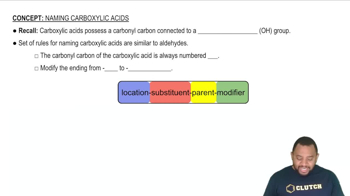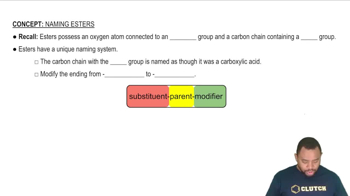Here are the essential concepts you must grasp in order to answer the question correctly.
Carboxylic Acids
Carboxylic acids are organic compounds characterized by the presence of one or more carboxyl groups (-COOH). They are known for their acidic properties, which arise from the ability of the carboxyl group to donate a proton (H+) in solution. Common examples include acetic acid (found in vinegar) and benzoic acid. The naming convention typically involves identifying the longest carbon chain containing the carboxyl group and adding the suffix '-oic acid.'
Recommended video:
Rules for Naming Carboxylic Acids
Esters
Esters are organic compounds formed from the reaction of an alcohol and a carboxylic acid, resulting in the replacement of the hydrogen in the carboxyl group with an alkyl group. They are often characterized by their pleasant fragrances and are commonly found in fruits and flowers. The naming of esters involves identifying the alkyl group from the alcohol and the acid part, leading to a name that ends with '-ate,' such as ethyl acetate.
Recommended video:
Nomenclature Rules
Nomenclature rules in organic chemistry provide a systematic way to name compounds based on their structure and functional groups. For carboxylic acids, the longest carbon chain containing the carboxyl group is identified, and the appropriate suffix is added. For esters, the names are derived from the alcohol and acid components, with specific endings. Understanding these rules is essential for accurately naming and identifying organic compounds.
Recommended video:

 Verified step by step guidance
Verified step by step guidance


